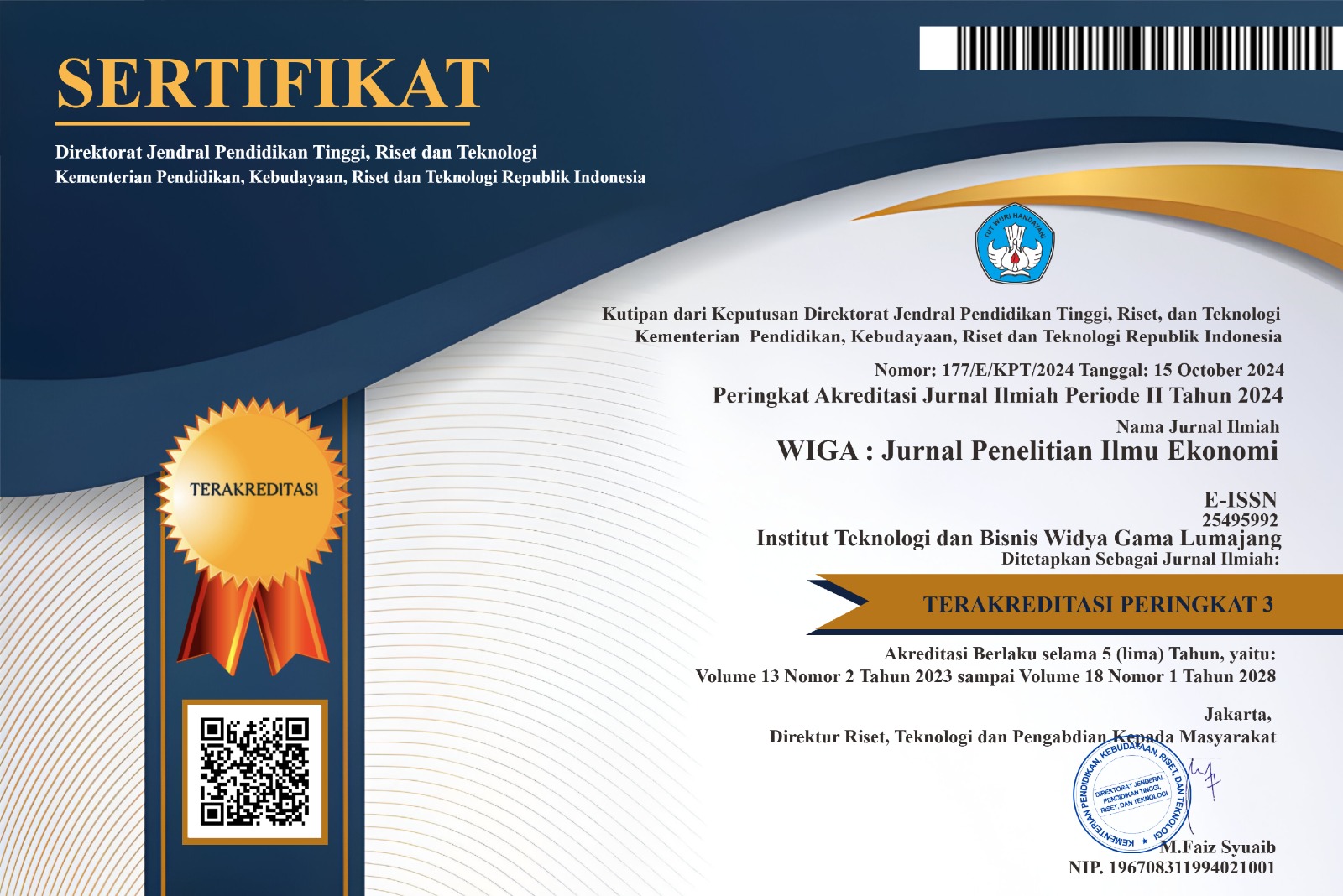Analysis of Consumer Buying Interest in Sanitary Napkin Products that are Green Products
DOI:
https://doi.org/10.30741/wiga.v15i1.1528Keywords:
Environmental Value, Awareness, Consumtion Values, Eco-Label, Purcase IntentionAbstract
Environmentally friendly products are designed and produced without causing adverse environmental impacts, including the use of sustainable materials. This is particularly important for sanitary napkin products, which serve as vital support for women during menstruation. For Generation Z women, sanitary napkins are not only viewed as protective products but also as a reflection of environmental values that enhance self-confidence in social interactions. This study aims to examine the factors influencing Generation Z’s purchase intention of green sanitary napkin products, focusing on the role of environmental values (environmental awareness, consumption value, and eco-label). This quantitative research employed a purposive sampling technique involving 100 female respondents from Generation Z in Malang who have experience using eco-friendly sanitary napkin products. The measurement of research variables was conducted using validated and reliable instruments, with reliability confirmed by Cronbach's Alpha and Composite Reliability (CR) tests, and validity tested through convergent and discriminant validity. Data were analyzed using the Structural Equation Modeling–Partial Least Squares (SEM-PLS) method following the stages of model measurement (outer model), structural model (inner model), and hypothesis testing. The results show that eco-labels do not significantly influence purchase intention, while environmental awareness and consumption value have a significant effect. This indicates that although Generation Z in Malang is aware of the importance of environmental protection, eco-labels are not the main factor in their purchasing decisions. Instead, their understanding of the value and benefits of environmentally friendly products plays a more dominant role.
Downloads
References
Chin, W. W., Chinn, W. W., & Chin, W. W. (1998). The partial least squares approach to structural equation modelling. In Marcoulides G. A. (Ed.). Modern Methods for Business Research, 295(2).
Fornell, C., & Larcker, D. F. (2016). Evaluating structural equation models with unobservable variables and measurement error. Journal of Marketing Research This, 18(1).
Fornell, C., & Larcker, D. F. (1981). Evaluating Structural Equation Models with Unobservable Variables and Measurement Error. Journal of Marketing Research, 18(1). https://doi.org/10.1177/002224378101800104
Gefen, D., & Straub, D. (2005). A Practical Guide To Factorial Validity Using PLS-Graph: Tutorial And Annotated Example. Communications of the Association for Information Systems, 16. https://doi.org/10.17705/1cais.01605
Gefen, D., & Straub, D. (2018). A Practical Guide To Factorial Validity Using PLS-Graph. Communications of the Association for Information Systems.
Hair, J. F., Jr., Hult, G. T. M., Ringle, C. M., & Sarstedt, M. (2021). A primer on partial least squares structural equations modeling (PLS-SEM). Sage Publications. Journal of Tourism Research, 6(2).
Hair Jr., J. F., Matthews, L. M., Matthews, R. L., & Sarstedt, M. (2017). PLS-SEM or CB-SEM: updated guidelines on which method to use. International Journal of Multivariate Data Analysis, 1(2), 107. https://doi.org/10.1504/ijmda.2017.10008574
Henseler, J., Ringle, C. M., & Sarstedt, M. (2015). A new criterion for assessing discriminant validity in variance-based structural equation modeling. Journal of the Academy of Marketing Science, 43(1). https://doi.org/10.1007/s11747-014-0403-8
Ketchen, D. J. (2013). A Primer on Partial Least Squares Structural Equation Modeling. Long Range Planning, 46(1–2). https://doi.org/10.1016/j.lrp.2013.01.002
Leni, I. N., Setyorini, R. H., Prasetya, T. B., & Hastuti, P. (2023). Correlation Between Knowledge Level About Cloth Sanitary Napkins and Interest in Using Cloth Sanitary Napkins for Young Women. JETISH: Journal of Education Technology Information Social Sciences and Health, 2(2). https://doi.org/10.57235/jetish.v2i2.1007
Lukiarti, M. M. (2021). Dampak Enviromental Concern, Advertisement Dan Electronic Word Of Mouth Pada Green Purchase Behavior. Jurnal Manajemen Dan Profesional, 2(1). https://doi.org/10.32815/jpro.v2i1.769
Pristya, T. Y. R., & Amalia, R. (2021). Edukasi Dengan Media Leaflet Dalam Upaya Peningkatan Pengetahuan Ibu Tentang Pembalut Kain. Jurnal Bakti Masyarakat Indonesia, 3(2). https://doi.org/10.24912/jbmi.v3i2.9428
Reinelda Tri Yunarni, B., & Hidayati Indra Ningsih, N. (2022). Pembuatan Pembalut Kain Dari Bahan Bekas Sebagai Peluang UKM Desa Jatisela Lombok Barat Making Cloth Wapters From Used Materials As An Opportunity For Smes In Jatisela Village Lombok Barat. Transformasi : Jurnal Pengabdian Pada Masyarakat, 2(3), 2797–7838. http://journal.ummat.ac.id/index.php/transformasi/index
Riptiono, S., & Yuntafi’ah, L. (2021). Attitude Toward Green Product Sebagai Pemediasi Antara Environmental Concern, Green Brand Knowledge Dan Green Purchase Intention. Jurnal Ekonomi Dan Teknik Informatika, 9(2).
Seifany, M., Made Sri Wahyuni Trisna, N., & Komang Angga Maha Putra, I. (2023). Perancangan Media Kampanye “Nyaman Saat Haid Dengan Menstrual Cup” Sebagai Alternatif Pembalut Sekali Pakai Di Denpasar (Vol. 4, Issue 2). https://jurnal.idbbali.ac.id/index.php/selarasrupa
Suhanti, I. Y. (2021). Cultural Aspects of Disposable Diaper Waste and Sanitary Napkins in Indonesia Aspek Budaya pada Pengolahan Sampah Popok Sekali Pakai dan Pembalut Wanita di Indonesia. In Jurnal Biokultur (Vol. 10, Issue 1).
Yuan, K. H., Wen, Y., & Tang, J. (2023). Sensitivity Analysis of the Weights of the Composites Under Partial Least-Squares Approach to Structural Equation Modeling. Structural Equation Modeling, 30(1). https://doi.org/10.1080/10705511.2022.2106487
Downloads
Published
How to Cite
Issue
Section
License
Copyright (c) 2025 Nur Jannah, Rena Febrita Sarie, Krisnadhi Hariyanto

This work is licensed under a Creative Commons Attribution-NonCommercial 4.0 International License.










